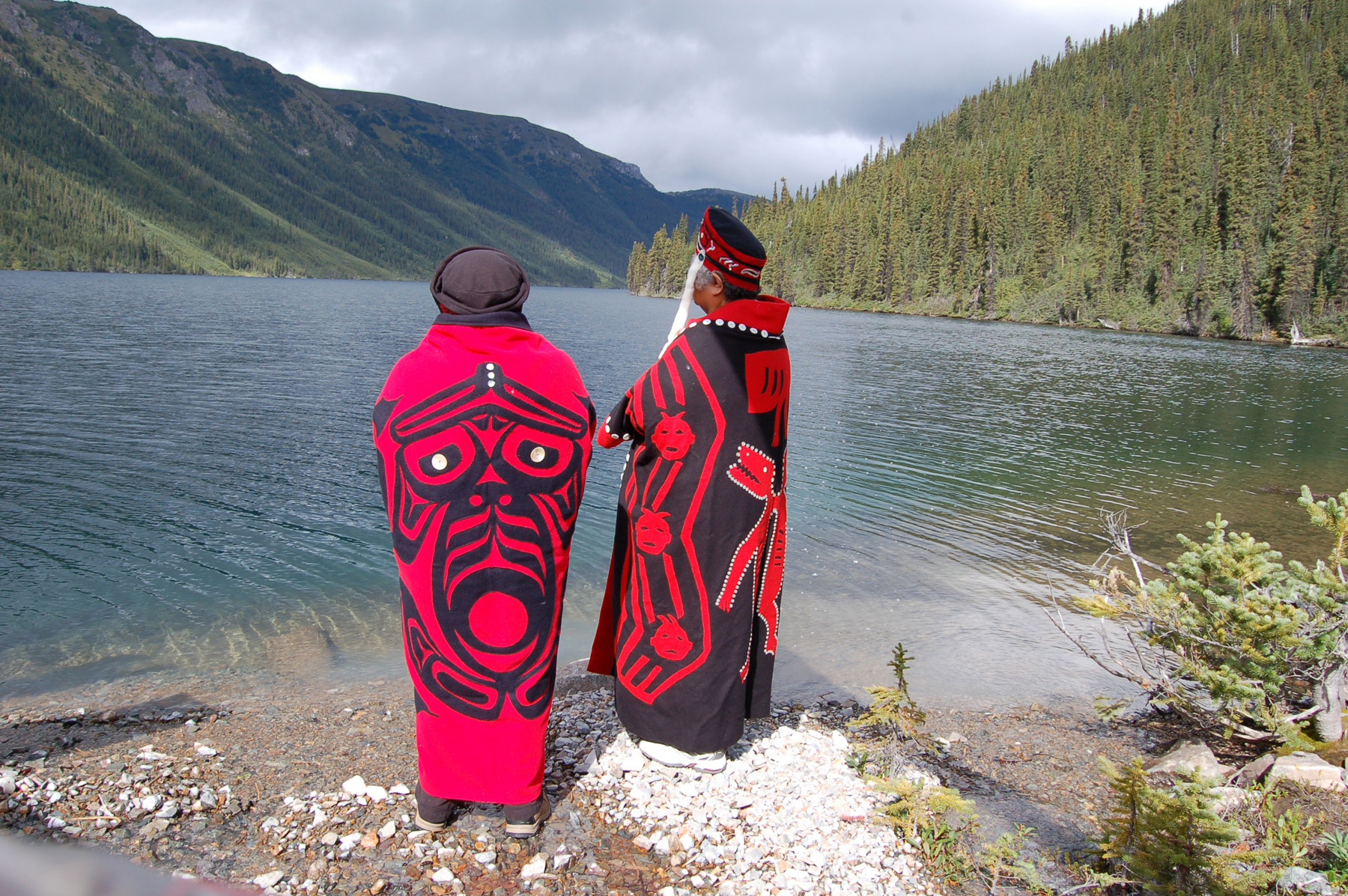The Kemess Decision About Aboriginal Title

Simgigyet Miluulak (Alice Jeffrey, left) and Nii Kyap (Rena Benson) on shores of Amazay Lake performing the eagle down ceremony Photo by Art Wilson
Opinion piece submitted by Doug Donaldson, Hazelton
The last notes of a lament song drifted across the mountain lake on a cool breeze that carried puffs of white eagle down. The peaceful, solemn ceremony performed by two Gitxsan hereditary chiefs in their regalia was in stark contrast to the activity at Northgate Mineral’s huge Kemess open-pit copper mine less than six kilometres away. It was also a sobering moment for the chiefs knowing that where they stood could be under 90 metres of water containing tons of acid producing mine tailings if Northgate had its way.
The Eagle Down ceremony performed by the chiefs that day in late August contained a prayer for the spirits of Amazay Lake and for the ancestors of chiefs Nii Kyap and Miluulak who protected its pristine waters for today’s generation.
That prayer was heard judging by recent results. On Sept. 17 a joint BC-Canada mining review panel recommended that Northgate Mineral’s plans for their new Kemess North copper-gold project, including using Amazay Lake as a tailings pond for 750 million tons of acid producing rock, “not be approved as proposed.”
When the chair of the mining review panel made that announcement in front of Gitxsan chiefs and their representatives at Gitanmaax Hall near Hazelton, a jubilant roar erupted from the more than 70 leaders gathered. The roar reverberated throughout the province and Canada. Now the echo coming back from many circles demonstrates a high level of ignorance on how far the issue of aboriginal rights and title has evolved in this country.
But its no wonder such a level of ignorance exists. Since the Gitxsan Delgamuukw Supreme Court of Canada ruling in 1997 provincial and federal government policy has failed to live up to the direction given by the highest court in the land. Despite the New Relationship deal promoted by the Gordon Campbell government in BC, his ministers continue to issue tenure permits to large companies for resource extraction activities on traditional First Nation territories without adequate consultation or accommodation. This leads to companies like Northgate charging ahead with a ludicrous proposals to kill a six-kilometre long, pristine mountain lake, and creating a toxic stew that would need to be contained and monitored for hundreds of years, for a economic benefit that may last for 11 years at the most. If BC had entered into genuine consultation with the Gitxsan on development proposals on the traditional territories, who knows what positive steps may have been created? At the least, a lot of investor’s money wouldn’t have been wasted by Northgate pursuing the lake as a tailings pond option and a significant amount of bureaucrats time, paid for by taxpayers, wouldn’t have been necessary in the three-year mining review panel process.
The echo from organizations like the Mining Association of BC and from the BC Liberal government, in the form of the comments by local MLA Dennis Mackay, are to be expected. It is the whole “jobs or the environment” red herring that is still part of a vocabulary that hasn’t caught up to current reality and the new standards society demands when considering the environment and aboriginal rights. Some in the resource extraction industry have caught up and, along with enlightened bureaucrats, are trying to push the envelope by engaging First Nations in meaningful consultation. But few elected politicians in the ruling BC Liberal or federal Conservative parties are up to speed on the new dynamics. This lack of leadership does not bode well for those of us living in remote, rural areas dependent on resource extraction for part of our economy, and healthy ecosystems for continued survival. Nor does it harbour well for those living in more urban areas who are dependent for their well being on natural resources found in the “heartlands”.
Meanwhile the Gitxsan and non-Gitxsan experience up to 90% unemployment in the 14 communities that are located on the 30,000 square kilometres of traditional territory in northwest BC. Hereditary chiefs like Miluulak and Nii Kyap are well aware of the dependence, despondency and dire social conditions that joblessness helps create. Yet they are also acutely cognizant that humans cannot be separated from the land and that a healthy ecosystem is imperative for a healthy people.
As Miluulak said after concluding the Eagle Down ceremony on the shores of Amazay Lake, “I don’t think we want to follow in the footsteps of Europe or Asia. Look at the Seine or the Danube. Look at the pollution. It’s abominable. There must be alternative methods of development that are economical other than poisoning a lake.”
The issue at the foundation of the mining review panel assessing Northgate’s proposal around the lake is aboriginal title. The precedent and direction on aboriginal title was set in 1997 by the Supreme Court. The sooner we stop dancing around this issue and get on with implementing a ruling that is now 10 years old, the better it will be for everyone living in BC and Canada.
Previous Story - Next Story
Return to Home








